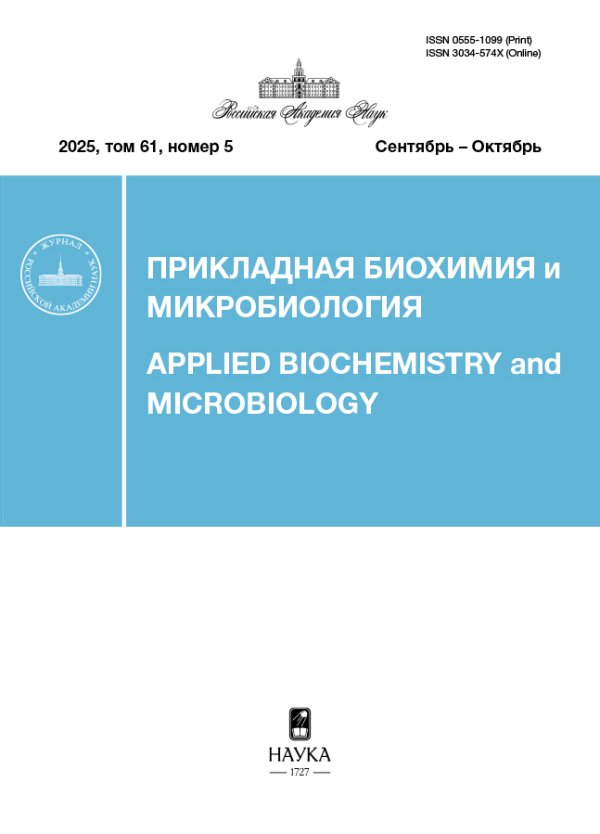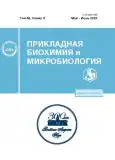Выявление “некультивируемых” клеток Mycobacterium tuberculosis культуральными методами
- Авторы: Демина Г.Р.1, Шлеева М.О.1, Багаева Д.И.1, Вострокнутова Г.Н.1, Капрельянц А.С.1
-
Учреждения:
- Институт биохимии им. А.Н. Баха, Федеральный исследовательский центр “Фундаментальные основы биотехнологии” Российской академии наук
- Выпуск: Том 59, № 3 (2023)
- Страницы: 244-252
- Раздел: Статьи
- URL: https://journals.rcsi.science/0555-1099/article/view/138770
- DOI: https://doi.org/10.31857/S0555109923020058
- EDN: https://elibrary.ru/LLCNVA
- ID: 138770
Цитировать
Полный текст
Аннотация
Выявлены особенности реактивации “некультивируемых” клеток (НК) Mycobacterium tuberculosis (МТБ) для последующего размножения в жидкой среде, а также предложен подход количественной детекции таких клеток культуральными методами. После инокулирования, полученных in vitro НК МТБ в стандартную жидкую среду Сотона, наблюдалась продолжительная (до 20 сут) лаг-фаза, при которой размножение клеток отсутствовало. В течение лаг-фазы клетки секретировали вещества неустановленной природы, тормозящие или полностью прекращающие реактивацию и рост культур при исходных концентрациях НК выше 107–108 кл./мл. Введение мясопептонного бульона (3.25 г/л) в стандартную среду Сотона со сниженной в 10 раз концентрацией глицерина существенно стимулировало реактивацию и размножение НК при их инокулировании в концентрациях выше порогового значения. Такая модификация состава среды позволяла выявлять до 103 раз больше клеток в популяции МТБ методом наиболее вероятного числа клеток (НВЧК). Увеличение числа детектируемых НК в популяции (в среднем 2.5 порядка) достигалось также добавлением в среду для реактивации рекомбинантного белка RpfB (5 нг/мл), одного из белков семейства Rpf – факторов реактивации покоящихся бактерий. Возможно, действие Rpf связано с продуктами его ферментативной активности, поскольку увеличение НВЧК в популяции НК наблюдалось также при добавлении продуктов гидролиза пептидогликана (ПГ) микобактерий, полученных совместным действием RpfB и эндопептидазы RipA. Подобный эффект оказывало также добавление озвученных фрагментов пептидогликана (ФПГ) в концентрации до 1 мкг/мл. Полученные результаты могут быть использованы в качестве подходов для оптимизации состава жидких сред и условий культивирования с целью выявления возбудителя туберкулеза в состоянии “некультивируемости” в клинических образцах.
Ключевые слова
Об авторах
Г. Р. Демина
Институт биохимии им. А.Н. Баха, Федеральный исследовательский центр“Фундаментальные основы биотехнологии” Российской академии наук
Автор, ответственный за переписку.
Email: Galyademina@yandex.ru
Россия, 119071, Москва
М. О. Шлеева
Институт биохимии им. А.Н. Баха, Федеральный исследовательский центр“Фундаментальные основы биотехнологии” Российской академии наук
Email: Galyademina@yandex.ru
Россия, 119071, Москва
Д. И. Багаева
Институт биохимии им. А.Н. Баха, Федеральный исследовательский центр“Фундаментальные основы биотехнологии” Российской академии наук
Email: Galyademina@yandex.ru
Россия, 119071, Москва
Г. Н. Вострокнутова
Институт биохимии им. А.Н. Баха, Федеральный исследовательский центр“Фундаментальные основы биотехнологии” Российской академии наук
Email: Galyademina@yandex.ru
Россия, 119071, Москва
А. С. Капрельянц
Институт биохимии им. А.Н. Баха, Федеральный исследовательский центр“Фундаментальные основы биотехнологии” Российской академии наук
Email: Galyademina@yandex.ru
Россия, 119071, Москва
Список литературы
- Эргешов А.Э., Черноусова Л.Н., Андреевская С.Н. // Вестник РАМН. 2019. Т. 74. № 6. С. 413–422.
- Shleeva M.O., Bagramyan K., Telkov M.V., Mukamolova G.V., Young M., Kell D.B., Kaprelyants A.S. // Microbiology. 2002. V. 148. № 5. P. 1581–1591.
- Medlar E.M., Bernstein S., Steward D.M. // Am. Rev. Tuberc. 1952. V. 66. № 1. P. 36–43.
- Beck F., Yegian D. // Am. Rev. Tuberc. 1952. V. 66. № 1. P. 44–51.
- Hobby G.L., Auerbach O., Lenert T.F., Small M.J., Comer J.V. // Am. Rev. Tuberc. 1954. V. 70. № 2. P. 191–218.
- Biketov S.F., Mukamolova G.V., Potapov V., Gilenkov E., Vostroknutova G.N., Kell D.B., Young M., Kaprelyants AS. // FEMS Immunol Med Microbiol. 2000. V. 29. № 4. P. 233–240.
- Dhillon J., Lowrie D.B., Mitchison D.A. // BMC Infect. Dis. 2004. V. 4. P. 4–7.
- Mukamolova G.V., Turapov O., Malkin J., Woltmann G., Barer M.R. // Am. J. Respir. Crit. Care Med. 2010. V. 181. P. 174–180.
- Shleeva M.O., Kudykina Y.K., Vostroknutova G.N., Suzina N.E., Mulyukin A.L., Kaprelyants A.S. // Tuberculosis (Edinb). 2011. V. 91. № 2. P. 146–154.
- Ghodbane R., Raoult D., Drancourt M. // Sci Rep. 2014. V. 4. P. 4236.
- Nikitushkin V.D., Demina G.R., Shleeva M.O., Guryanova S.V., Ruggiero A., Berisio R., Kaprelyants A.S. // FEBS J. 2015. V. 282. № 13. P. 2500–2511.
- Parish T., Stoker N. // Methods in molecular Biology. In Mycobacteria protocols, Humana Press, Totowa, NJ. 1998. P. 91–107.
- Mahapatra S., Crick D.C., McNeil M.R., Brennan P.J. // J Bacteriol. 2008. V. 190. № 2. P. 655–661.
- Du Bois A.B., Botelho S.Y., Bedell G.N., Marshall R., Comroe J.H. Jr. // J Clin Invest. 1956. V. 35. P. 322–326.
- Shleeva M.O., Kudykina Y.K., Vostroknutova G.N., Suzina N.E., Mulyukin A.L., Kaprelyants A.S. // Tuberculosis (Edinb). 2011. V. 91. № 2. P. 146–154.
- Mukamolova G.V., Kaprelyants A.S., Kell D.B. // Antonie Van Leeuwenhoek. 1995. V. 67. № 3. P. 289–295.
- Shleeva M.O., Trutneva K.A., Demina G.R., Zinin A.I., Sorokoumova G.M., Laptinskaya P.K., Shumkova E.S., Kaprelyants A.S. // Front Microbiol. 2017. V. 8. P. 524.
- Nikitushkin V.D., Trenkamp S., Demina G.R., Shleeva M.O., Kaprelyants A.S. // Metabolomics. 2020. V. 16. № 2. P. 24.
- He Z., De Buck J. // BMC Microbiol. 2010. V. 10. P. 121.
- Кудыкина Ю.К., Шлеева М.О., Арцатбанов В.Ю., Сузина Н.Е., Капрельянц А.С. // Микробиология. 2011. Т. 80. № 5. С. 625–636.
- Postgate J.R., Hunter J.R. // Nature. 1963. V. 198. P. 273.
- Nikitushkin V.D., Demina G.R., Shleeva M.O., Kaprelyants A.S. // Antonie Van Leeuwenhoek. 2013. V. 103. № 1. P. 37–46.
- Shleeva M.O., Goncharenko A.V., Kudykina Y.K., Young D., Young M, Kaprelyants A.S. // PLoS One. 2013. V. 8. № 12. e82914. https://doi.org/10.1371/journal.pone.0082914
- Назарова Е.В., Шлеева М.О., Морозова Н.С., Кудыкина Ю.К., Вострокнутова Г.Н., Ружицкий А.О., Селищева А.А., Сорокоумова Г.М., Швец В.И., Капрельянц А.С. // Биохимия. 2011. Т. 76. № 6. С. 781–791.
- Zainabadi K., Walsh K.F., Vilbrun S.C., Mathurin L.D., Lee M.H., Saito K., Mishra S., Ocheretina O., Pape J.W., Nathan C., Fitzgerald D.W. // Antimicrob. Agents Chemother. 2021 V. 65. № 8. e0060821. https://doi.org/10.1128/aac.00608-21
- Hett E.C., Chao M.C., Steyn A.J., Fortune S.M., Deng L.L., Rubin E.J. // Mol. Microbiol. 2007. V.66. № 3. P. 658–668.
- Hett E.C., Chao M.C., Deng L.L., Rubin E.J. // Plos pathogens. 2008. V. 4. № 2. e1000001. https://doi.org/10.1371/journal.ppat.1000001
- Ruggiero A., Marasco D., Squeglia F., Soldini S., Pedone C., Berisio R. // Structure 2010. V. 18. № 9. P. 1184–1190.
Дополнительные файлы


















